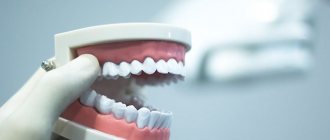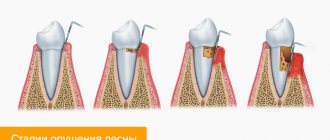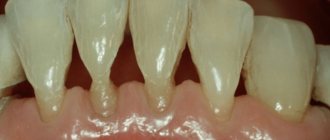Classification Causes of recession Diagnosis and consequences of recession Treatment methods Prevention
Gum recession is the process of loss of gum tissue, which exposes the neck of the tooth root. Visually it looks like this: due to the exposure of the root part, the teeth appear longer, and a small groove is formed at the edge of the gum. The sensitivity of teeth to sour, sweet, salty and temperature changes increases. Gum recession can occur in the area of one tooth or several. However, to establish an accurate diagnosis, you need to contact the dentist.
Features of treatment
Gum recession is a consequence of impaired circulation of periodontal tissues that nourish bone tissue, resulting in bone atrophy and a decrease in gum level towards the root. The difficulty of treatment is that the loss of soft tissues has an extensive etiology and occurs under the influence of a number of factors:
- inflammatory process and accumulation of plaque and granulation tissue in periodontal pockets;
- improper brushing technique;
- errors in prosthetics;
- mechanical damage, chemical and thermal burns;
- malocclusions, poor-quality orthodontic treatment;
- elderly.
Only in the latter case does recession develop independently, that is, as a consequence of the aging of the body and the mucous membrane in particular. In other situations, the disease is provoked by very specific factors, so successful recovery from gum recession is possible only after identifying and stopping the underlying pathology. For example, in case of periodontitis, it is necessary to remove all dental plaque and carry out anti-inflammatory therapy. If the recession is associated with orthodontics, then it is necessary to correct the bite or replace an incorrectly installed brace system. The same applies to prosthetics: often it is low-quality or incorrectly manufactured dentures that contribute to injury and death of soft tissues.
Causes of receding gums
Gum recession can be caused by various factors. Self-diagnosis is the first step to identifying the problem, so as not to pay too high a price for inattention. Below are the most common causes of recession:
- improper
oral hygiene. For example, too aggressive brushing of teeth: using a hard toothbrush, mechanical damage during dental care; - lack
of oral care. If plaque is not removed, it will lead to the formation of tartar, which in turn causes gum disease and recession; - periodontal disease
. This gum disease is often accompanied by gum recession. If treatment is not done in time, this will lead to tooth loss; - natural aging
of the body; - bad habits
: biting lips and nails, biting pens, pencils, smoking; - traumatic, inaccurate dental treatment
, including whitening procedures.
In addition, structural features
oral cavity, jaw (bite pathology, arrangement of individual teeth, shortened lip frenulum, etc.) and somatic diseases (metabolic syndrome, diabetes mellitus, etc.).
Indications for closing gum recession
Elimination of gum recession is necessary when the first visual signs appear, that is, when its free edge drops. In this situation, the only effective way is surgery. Conservative treatment of recession is carried out at the stage when the patient has not yet observed changes in the shape and position of the gingival margin. Analysis of symptoms and diagnostic procedures help identify predisposition to the disease. Increased sensitivity of teeth, inflammation, bleeding, an abundance of plaque and tartar - all these symptoms clearly hint at a pathological process, which sooner or later will lead to more serious complications. Another warning sign is the individual structure of the gums. A narrow and thin layer of attached gum (in simple terms, its base) and a wide root part of the tooth clearly indicate a high predisposition to the development of recession.
Classification
Depending on the preservation of gum tissue, there are 4 stages of gum recession:
- In the first stage, only the attached part of the gum decreases. The decrease in tissue volume is insignificant.
- The area of the attached gum is destroyed, but the bone and gum tissue are preserved, and tooth sensitivity increases.
- In the third stage, the outer surface of the tooth is exposed, and tooth sensitivity becomes painful.
- The tooth is exposed around the perimeter, including in the interdental spaces.
Receding gums are a gradual process. In most cases, it is caused by a specific dental disease. The gums become thinner and smaller, resulting in tooth mobility and loosening, which can lead to their loss.
How to stop gum recession?
Therapeutic treatment of gum recession is aimed primarily at eliminating the inflammatory process, normalizing the microflora of the oral cavity, increasing immunity and the body's protective properties.
Therapeutic techniques
- Professional cleaning and sanitation of the oral cavity.
It is used as a preventive measure, and is also the first step in the treatment of the inflammatory process. - Closed curettage of periodontal pockets.
A therapeutic procedure for removing dental plaque in periodontal pockets. - Treatment of gum recession with laser.
Photodynamic laser therapy or laser curettage is performed. - Anti-inflammatory therapy.
The doctor prescribes gels, ointments and rinses (usually topical use), which have antimicrobial and anti-inflammatory properties. - Antibiotic therapy.
- Taking vitamins and supplements.
During recession, vitamins C, D, B9 are prescribed, as well as preparations containing the protein amelogenin, which helps restore soft and hard tissues.
Surgery
- Treatment of damaged tissues and suturing.
The simplest manipulation that is performed during recession, when the gums are damaged as a result of mechanical stress. - Flap surgery.
Gum recession plastic surgery, when donor tissue is taken from a healthy area of the mucous membrane to “close” the missing fragment. Allows you to restore 2-3 millimeters of the level of the mobile gum. The advantage of this technique is the relative speed of the operation and a completely acceptable result. Disadvantages: invasiveness, the need to collect donor tissue and the possibility of rejection. In some situations, the color of the donor tissue may be slightly different, which negatively affects the aesthetics. - Tissue regeneration.
It is carried out using a fibrin membrane - a tissue growth stimulator, which resembles a dense clot and is implanted into the site of recession after preparatory surgical procedures. To produce the membrane, blood is required from the patient, but the healthy area of the gum is not harmed (unlike flap surgery). This technique has a number of advantages: minimally invasive, the possibility of treatment in complex cases, rapid tissue restoration and the absence of the risk of repeated recession. The gums after surgery to eliminate recession look healthy and natural. - Treatment of gum recession with collagen.
Implantation of collagen implants of natural origin for tissue restoration. The implants contain fibrillar protein, which is the basis of connective tissue. Previously, collagen was removed after treatment, but modern implants do not require this and dissolve on their own. This method is especially effective for age-related recession.
The gums are receding - what can I rinse with and what ointments should I use?
Unfortunately, it is impossible to cure gum recession (recession) with home remedies or conservative methods, i.e. with the use of medications. To correct the situation, procedures in a dental clinic are always necessary.
But, since one of the reasons for receding gums is an inflammatory process, the dentist can select anti-inflammatory home care products for the patient. These include medicinal pastes, which can only be used as prescribed by a doctor, as well as gels, ointments, rinses, etc.
Quite often, the following are used to treat inflammation in the oral cavity:
- Cholisal
is a gel based on choline salicylate, which has an analgesic, anti-inflammatory and antiseptic effect that lasts 3-8 hours, - Metrogyl Denta
- includes the antibiotic metronidazole and the antiseptic chlorhexidine, especially effective at the initial stage of inflammation, - Solcoseryl
- ointment heals wounds, improves nutrition of injured tissues, and is often used after operations in the oral cavity.
Anti-inflammatory rinses work due to chlorhexidine, herbal components (extracts of geranium, sea buckthorn, hawthorn, sage and chamomile) or a combination thereof. There are a lot of such products on the market, and it is best to consult a dentist before purchasing. It is also important to remember that you should not prescribe any medications to yourself - this may not improve the situation, but rather make it worse.
Treatment at home
Treatment of gum recession at home is impossible, since in advanced stages of the disease only surgical intervention can correct the situation. It is not possible to get rid of gum recession with ointments, gels and tinctures: at best, they will help cope with inflammation, but they cannot restore the edges of the gums. Anti-inflammatory therapy is used only as an addition to the main treatment. Folk remedies should be used only on the recommendation of a doctor or as a preventive measure. In the absence of pharmaceutical drugs, folk remedies may provide some benefit. A solution based on soda and salt, propolis extract, decoctions of oak bark, juniper and chamomile are just a small part of the folk recipes that can be used for gum diseases.
Strengthening gums: the right approach
Strengthening gums and teeth during gingivitis and periodontitis is possible in 2 options. Firstly, it is undergoing a professional course of treatment at the dentist, which primarily includes ultrasonic cleaning of teeth from stone and plaque. Plus a course of anti-inflammatory therapy, consisting of antiseptic rinses and special gels for the gums, which (with the exception of severe cases of periodontitis) can be easily carried out at home.
The second option concerns strengthening the gums in between courses of professional gum treatment at the dentist. If during the period of professional treatment (after removing dental plaque) products containing antiseptics and antibiotics are used, then for long-term maintenance therapy anti-inflammatory drugs are used, which will not cause harm with constant long-term use. We hope that it has become clear to you: the correct approach to gum treatment includes both professional treatment at the dentist and supportive treatment at home.
1) Removal of tartar and plaque –
How important it is to professionally clean your teeth to remove plaque and tartar, and how the condition of your gums changes just a few days after high-quality removal of dental plaque – you can see in Figure 9-10. But we once again draw your attention to the fact that in case of periodontitis, it is best to remove dental plaque not from a dentist or hygienist, but from a periodontist.
→ Video of ultrasonic teeth cleaning procedure
2) Anti-inflammatory therapy –
After removing dental plaque, the doctor will prescribe you anti-inflammatory therapy, which you can do at home. Only in cases of severe periodontitis and deep periodontal pockets (in parallel with home therapy), the doctor usually schedules an appointment once a day (for 10 days) to rinse the periodontal pockets with antiseptics. The course of treatment usually lasts 6-7 days for gingivitis, and 10 days for periodontitis.
Home therapy consists of antiseptic rinses and applications of anti-inflammatory gel to the gums. Gum treatment is carried out 2 times a day. The following drugs are usually used in the complex: Chlorhexidine solution for rinsing (its concentration can be from 0.05 to 0.25%, which will depend on the severity of inflammation), and CholisalGel for applications. How to properly treat gums with these drugs is described in detail by us in the article at the link below:
→ Treatment of gum diseases
Important : if you decide to start drug treatment, ignoring the need to remove dental plaque, then remember that behind the visible temporary decrease in the symptoms of inflammation from such treatment, you will receive a subtle, increasing destruction of the attachment of the tooth to the gum and bone tissue. Over time, it will lead to tooth mobility, their removal, and the need for expensive treatment methods (for example, splinting teeth with fiberglass or curettage of gum pockets).
What to do to prevent the disease?
Preventive measures do not provide a 100% guarantee that you will never experience gum recession, but following them will help minimize the risks:
- regular and high-quality hygiene;
- professional cleaning of dental plaque;
- using a medium-hard toothbrush and proper brushing technique;
- timely diagnosis of caries and inflammatory processes;
- taking vitamins and amelogenin if there are risks of recession;
- giving up bad habits, especially smoking;
- correction of malocclusions, if you have them.
Diagnosis and consequences of gum recession
Timely diagnosis of gum recession helps to quickly eliminate the problem and prevent the development of unpleasant consequences. To carry out self-diagnosis, you need to know the following symptoms:
- the gums are red and inflamed;
- some teeth look longer than others;
- Gaps have appeared between the roots of the teeth and continue to grow;
- high sensitivity of teeth appeared;
- there is an unpleasant odor from the mouth.
If one or more signs are detected, you must immediately consult a dentist to immediately begin treatment for receding gums. Otherwise, in addition to physical discomfort, the risk of developing caries and pulpitis increases. This happens due to the active proliferation of bacteria in the root part of the tooth, where the enamel is thinnest. Ultimately, if the process is left to chance, it will lead to loosening of the teeth and even their loss.
The more advanced the disease, the more difficult the treatment and the more the cost of such an operation increases. Therefore, there is no point in delaying a visit to the clinic.
There is no inflammation with periodontal disease
When does the so-called periodontal disease, there is no inflammatory process in the gums. The clinical picture of “periodontal disease” differs sharply from periodontitis; it is with periodontitis of the tooth that inflammation occurs.
And injections into the gums, endless restorations of the necks of the gums - this is running in circles. Over time, again all the restoration fillings are chipped, and again these patients come to have these fillings restored again. And this happens endlessly
:
And the diagnosis of “periodontal disease” does not go away. As Desna ran away, she continues to leave. The fillings increase, that is, the teeth increase in size, because the gums sag more and more, and nothing useful happens.
When such a patient gets an appointment with me, unwinding his entire tangle of ordeals during the consultation, it becomes clear that all previously performed gum treatment consists of 3
factors:
- Lost time,
- lost money
- shattered hopes.
The diagnosis was incorrect and the treatment was appropriate for the incorrect diagnosis. What went wrong?
Patients should always go for a consultation with such a diagnosis... to an orthodontist
.
Because periodontal disease is an occlusal injury
.
What I see in these patients with signs of periodontal disease is a completely different diagnosis. This is an occlusal injury that can only be corrected by an orthodontist.










